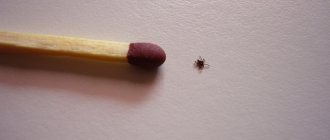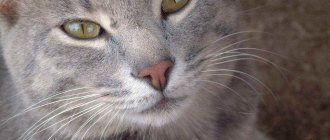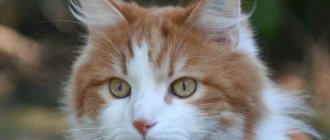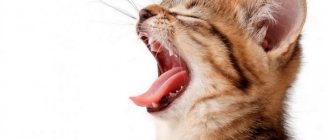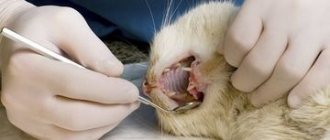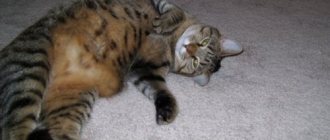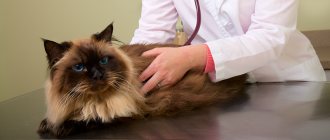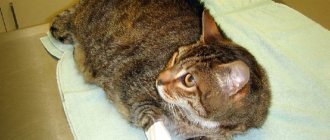Due to lack of hygiene, periodontal disease occurs in cats. This disease contributes to the destruction of enamel, bone structures and gums. The disorder causes severe discomfort and pain, which leads to a deterioration in the animal’s appetite. Treatment requires immediate cleaning of the teeth and removal of damaged units. For prevention, doctors recommend carefully monitoring the pet’s diet and mouth cleansing.
Periodontal disease and periodontitis: what is the difference?
Very often one of the names of diseases circulates among pet owners. However, periodontal disease and periodontitis are fundamentally two different nosological units. It is important for veterinarians to know this in order to make a correct diagnosis of cats, prescribe the correct therapy and further prevention.
Distinctive features of periodontal disease and periodontitis:
- Periodontitis is an acute inflammatory disease of the gums, leading to periodontal destruction, the course of which most often does not exceed 30 days, while periodontal disease is a chronic phenomenon, developing extremely slowly, possibly with an intermediate pathological condition (gingivitis).
- The main process in periodontitis is inflammation, while, as in periodontal disease, it is degeneration and destruction of bone tissue.
- With periodontitis, without the necessary therapy, teeth fall out within 60-90 days. With periodontal disease, teeth can be preserved for several years.
Reference!
There are situations when periodontal disease is accompanied by a secondary infection and the appearance of an inflammatory process on the gums. This may somewhat complicate the differential diagnosis of pathological processes.
Stages of violation
In cats, several main stages of periodontal damage are noted.
Redness and swelling of the gums, a putrid odor from the mouth, the presence of plaque and tartar indicate the initial stage of dental problems.
The degree of progression of the disease can only be accurately determined using x-rays. There are three stages:
- Initial deficiency of bone mass in the gum, not exceeding a quarter of its volume.
- Loss of 50% of gum bone mass.
- Inflammatory processes during periodontal destruction, which leads to tooth loss and serious disorders in the gums.
Owners can only treat their pet at the initial stage, but they should not self-medicate. It is necessary to show the animal to a qualified specialist to make an accurate diagnosis.
Main symptoms of the disease
It is not difficult to notice periodontal disease in a cat. The disease begins with complications in the gums and oral cavity. Bad breath, redness and swelling of the gums are the first signs of the onset of the disease. At this time, the animal can completely refuse hard food, preferring soft types of cat food. You can often notice a deterioration in the animal’s appetite or a complete refusal to eat. When pressing on the gums, bleeding is noticed. At this time, the animal experiences pain and may show aggression.
Depending on the stage of the disease, loose teeth may be noticeable. The gum margin is completely destroyed, leading to tooth loss. Periodontal disease in cats, the symptoms of which are easy to notice, begins to manifest itself in the form of inflammatory processes and suppuration. During this period, the animal must be immediately taken to a veterinarian. After all, the disease will not stop there, but will progress, affecting healthy teeth.
Stages of disease development and their symptoms
Like many diseases in veterinary medicine, periodontal disease has a gradual development of clinical manifestations. There are 4 stages in total:
- Stage 1 – the presence of only clinical manifestations. The X-ray picture of the jaw and teeth is within normal limits. In this case, the cat exhibits clinical manifestations. The gums show severe swelling and redness. When examining the teeth, tartar is detected (accumulated plaque from a long absence or improper sanitization of the cat’s mouth). Due to the active proliferation of bacterial flora, an extremely unpleasant or even putrid odor will emanate from the pet’s mouth.
Reference!
According to modern ideas of veterinarians, at the first stage of the development of periodontal disease, a diagnosis of “gingivitis” should be made, since it is impossible to differentiate these 2 conditions based on clinical manifestations.
- Stage 2 – the appearance of changes in the x-ray of the cat’s jaw. It becomes clearly visible that the amount of bone tissue has decreased by ¼ part (25%) of the required amount.
- Stage 3. Dystrophy reaches the periodontium. The volume of bone tissue is already reduced by ½ of normal. The clinical picture is also accompanied by severe bleeding of the gums, which can be easily provoked even by a light touch to the pathological gum.
- Stage 4. All pathological processes are accompanied by a purulent secondary infection. Purulent foci appear not only on the gums themselves, but throughout the animal’s entire oral cavity. The alveolar processes of teeth are subject to severe destruction. The cat's teeth are very loose and can fall out spontaneously.
Important!
Since cats are extremely patient animals, in the first stages of the development of the disease, it is very rare for owners to bring the animal to the clinic. However, in the final stages, the disease is much more difficult to treat and is much more painful for the cat to tolerate. It follows from this that you need to take care of your pet’s oral cavity.
Symptoms of the disease
In the first stages, due to the development of inflammation, swelling appears and the gums become red. The cat refuses solid foods due to pain when eating. Bleeding occurs from the gums around the roots of the teeth. Violation of the integrity of the gums leads to loosening and tooth loss. In the later stages, the periodontal tissue and gum margin are destroyed. Pus begins to ooze from the damaged areas. Abscissas may appear in the tissue of the oral cavity. Due to constant discomfort and pain, the animal becomes aggressive and unfriendly.
Signs of the disease also include:
- excessive salivation;
- unpleasant rotten odor from the mouth;
- the appearance of suppuration;
- white gums;
- the roots of the teeth are visible;
- loss of appetite.
Signs, symptoms
Veterinarians recommend performing oral exams on your pets at least once a week. Animals may have injured mucous membranes, threads may become tangled in their teeth, or carious lesions, so you need to brush your pet’s teeth twice a week to avoid troubles in the animal’s oral cavity.
Signs of caries are:
- Darkening of the enamel of the diseased tooth;
- Bad breath;
- Profuse salivation
- Changes in the animal's behavior while eating. For example, the cat will begin to chew food on only one side, or will try to swallow immediately without chewing.
- Pain while chewing;
- Loss or decreased appetite.
The pet will not be able to complain to the owner about the pain; he usually begins to avoid touching the diseased tooth.
When a cat suffers from tooth pain, its behavior changes dramatically. Many begin to behave aggressively.
During a toothache, a pet may scratch its face with its paw, meow pitifully, or sit motionless for a very long time and keep its mouth open.
With regular examinations, the cat owner will be able to detect the appearance of caries in the early stages.
You should pay attention to redness and swelling of the gums, the appearance of dark spots on the teeth and an unpleasant, putrid odor from the mouth.
Reference!
As soon as at least one of the listed signs is noticed, the pet must be immediately shown to a veterinarian. There is no need to brush your cat's teeth with human toothpaste against caries; this procedure will not bring any effect.
How dangerous is the disease?
Even though this is a gum disease, the consequences for cats can be dire. For example:
- Periodontal disease in cats leads to tooth loss. Not only is this not aesthetically pleasing (after all, a cat with beautiful teeth in full is more beautiful, isn’t it?), it also makes the cat’s life much more difficult, since it becomes impossible for him to chew food.
Reference! With the development of periodontal disease, even if they have teeth, cats do not chew food, but try to swallow it whole. This is due to severe pain in the cat, which he tries to avoid in this way.
- With periodontal disease, active reproduction of various pathogenic microorganisms occurs in the oral cavity, the waste products of which are toxic to the cat’s body. This affects the general condition of the fluffy’s body.
- If the cat is old, pregnant, or has a weakened immune system for any other reason, periodontitis can lead to such a serious complication as sepsis, which can lead to the death of the animal.
Reference!
Sepsis is a severe generalized condition of the body that occurs when an infectious agent enters the blood of an animal. The literal translation from Latin is putrid blood.
It is within the power of the owners to prevent the development of complications. To do this, it is enough to take the cat to a veterinary doctor on time and strictly follow his recommendations, even if this will not be very pleasant for the pet.
Causes
There are some known reasons why such an unpleasant disease occurs in the cat breed:
- Insufficient amounts of macroelements and minerals in the animal’s diet;
- Lack or absence of iodine, phosphorus and fluorine in the body;
- Lack or deficiency of vitamin B;
- Eating bones and roughage leads to mechanical injuries, which can cause caries in cats.
- Tartar, which appears in the form of plaque, eventually leads to caries.
- Metabolic disorders and weak immunity are favorable conditions for problems with tooth enamel;
Causes of periodontal disease
One animal may have several reasons for its dental problems.
Lack of oral hygiene
Simply put, the cat does not brush its teeth. Over the course of life, teeth become increasingly covered with soft plaque. Plaque is 80% a bacterial colony. The remaining 20% is the epithelium of the oral cavity, saliva, and food particles. When saturated with calcium salts, plaque turns into tartar - a hard brown mass that cannot be removed with any brush.
The waste products of bacteria trigger a strong inflammatory process in the gums (gingivitis). The gums gradually “dissolve”, move away, and pockets and subgingival tartar form. Periodontal pockets are already a sign of destruction of the jaw bone around the tooth.
The older the cat, the greater the likelihood of developing periodontitis.
Infectious diseases
Inflammation of the gums and mucous membranes of the oral cavity (gingivostomatitis) is sometimes caused by viral diseases of cats:
- immunodeficiency (FIV) and leukemia (FeLV);
- calicivirus;
- rhinotracheitis (herpes virus).
If left untreated, gingivitis gradually progresses to periodontitis.
Non-communicable systemic diseases
- Diabetes. Diabetes inhibits the healing of any tissue, including those destroyed by infection. Decreased immunity in diabetic cats provokes increased proliferation of bacteria in the oral cavity.
- Kidney failure. Toxic products of protein metabolism are not excreted by the kidneys and begin to be released in the form of ammonia through the mucous membranes, corroding them. In older cats, you can see not only severe inflammation of the gums, but also ulcers on the tongue and cheeks.
- Irregularity of teeth. It is found in certain breeds - Persians, Exotics, British. Flat-faced (brachiocephalic) cats have a jaw that is too short to accommodate the natural number of teeth. As a result, the teeth are crowded, crooked and at random. They cannot be cleaned naturally and quickly become overgrown with tartar. Teeth can grow unnaturally for other reasons: jaw fracture, malocclusion (overshot, undershot).
- Genetic predisposition. Some cats can live 15-20 years without serious dental problems. In others, massive tartar and loss of molars are observed as early as 8-12 years of age. When this cannot be attributed to other factors, it is obvious: dental and oral health can be inherited.
Improper feeding
Eating only soft foods does not put stress on the teeth when chewing. In animals, teeth must work, this strengthens the ligament of the tooth and gum tissue. Wet canned food or cereal accumulates on teeth, accelerating the development of tartar. Soft food does not clean teeth mechanically, as happens when chewing cartilage or dry food granules. The composition of the feed itself is also important.
A complete dental examination, including x-rays of the jaws, is carried out only under general anesthesia. In this regard, doctors prescribe examinations not only to find out and eliminate the cause of periodontal disease, but also to assess the risk of anesthesia for the patient.
At the initial appointment
- Detailed clinical and biochemical blood test (after a 10-12-hour fasting diet).
- Oral rinsing for rhinotracheitis and calicivirosis.
- Blood test for immunodeficiency virus and leukemia.
Before giving anesthesia
- Ultrasound examination of the heart (ECHO-cardiogram).
- If necessary, other studies in which the anesthesiologist sees a need: x-ray of the lungs, blood clotting test.
Examination under sedation
The dentist examines the entire oral cavity. First, dental plaque is removed with an ultrasonic scaler. After this, using a thin probe, the depth of the pockets around each tooth is determined, and the degree of recession (exposure of roots) or gum growth is assessed. Ulcers are noted on the oral mucosa (most often these are areas in contact with massive tartar). If neoplasms are noticed, a piece of tissue should be taken for analysis.
It is necessary to conduct intraoral radiography, which allows you to clearly see the condition of the roots of the teeth and the degree of destruction of the jaw bone. X-rays can detect jaw tumors or abscesses.
After diagnosis, the doctor draws up a treatment plan. Often, examination, photographs and therapeutic procedures can be done under one anesthesia.
Sanitation of the oral cavity
Teeth cleaning
Treatment of periodontitis is impossible without thorough removal of tartar above and below the gum. Use a scaler with suitable tips. The oral cavity is washed generously with chlorhexidine.
Tooth extraction
After the teeth are freed from stone, those that cannot be saved are removed. In doubtful cases, rely on X-ray data.
It happens that to cure a cat it is necessary to remove all the molars, except for the fangs (occasionally, including the fangs). It is very important to remove the teeth by the roots, otherwise the inflammation will not be overcome. X-rays help detect the roots of long-lost teeth, where there is no visible crown, covered with inflamed gums.
After total extraction of teeth, an x-ray is taken again, the gums are cleaned and sutured with absorbable material.
Teeth polishing
If the doctor decides to save some of the teeth, then after thoroughly cleaning the surface, they must be polished. This makes it harder for soft plaque to stick, slowing down the re-formation of tartar.
Drug treatment
After sanitation of the oral cavity, a short course of painkillers and anti-inflammatory drugs (Loxicom suspension, tablets or ketofen injections) is prescribed.
Antibacterial agents are used to fight infection. Local medications are very difficult to use at home; it is a lot of stress for the cat and its owners. Sometimes doctors prescribe irrigation of the gums with an antiseptic (Miramistin, chlorhexidine, Iodinol) and local gels (Cholisal, Metrogil-denta).
A broad-spectrum systemic antibiotic is more often used if the process is advanced. The first choice drugs are amoxiclav in combination with clavulonic acid (Sinulox) and a special antibiotic for the oral cavity - Stomorgyl.
The cat is fed soft food for several days after surgery. Then, even with total tooth extraction, the pet will be able to eat dry food. If only part of the teeth have been removed, it is necessary to maintain oral hygiene at home in the future.
It is general anesthesia and the prospect of removing a large number of teeth that sometimes frighten the owner. Such treatment, if the information is presented incorrectly, looks repulsive. Sometimes an unqualified specialist himself does not undertake the operation, hiding behind the fact that “the cat is old and will not tolerate anesthesia” and other excuses.
It is important to understand that it is impossible to cure periodontal disease without proper cleaning of the oral cavity. You can smear bleeding gums with Metrogyl over tartar for years, take one course of antibiotics after another, and in desperation decide to take a course of prednisolone. Only this is not a treatment, but its appearance, to calm one’s own conscience. Without removing tartar, and more often the teeth themselves, all these actions are meaningless and even harmful: they exhaust the patience and wallet of the owner, and cause stress to the animal.
Why does periodontal disease occur?
The most important reason for the occurrence of periodontal disease is the lack of proper care for the cat’s oral cavity. Among the abundance of the latest developments in dentistry (specialized toothbrushes and pastes for cats, developed by veterinarian dentists), the presence of many salons providing teeth cleaning services, and recommendation articles on the Internet, owners still neglect the dental health of their charges.
Just like humans, cats have food particles left on their teeth, which gradually leads to the formation of plaque on their teeth. The cat's teeth turn yellow. If this sign is further ignored, food debris accumulates more and more on the teeth and gums, which leads to the formation of tartar - a hard plaque located at the junction of the tooth and gum.
This stone is a good nutrient medium for oral microflora. Bacteria actively multiply, which initially leads to gingivitis and then to periodontal disease.
However, insufficient hygiene of the cat’s mouth is not the only reason for the appearance of pathology. Periodontal disease also develops due to:
- Injuries to the mucous membranes in the oral cavity. The most trivial situations of trauma (a fight with another animal, a scratch from fish bones, etc.) can lead to periodontal disease.
- Vitamin deficiency and deficiency of micro- and macroelements. Very often, a domestic cat cannot independently maintain the mineral and vitamin balance in its body, so this responsibility is entirely transferred to the shoulders of the owner.
- Periodontal disease can often appear as a result of any malfunction of the pet’s gastrointestinal tract.
- Inflammatory diseases of the oral cavity (gingivitis, stomatitis) serve as the beginning of periodontal disease.
Attention!
If the slightest deviation in the diet or appearance of the cat’s gums and teeth appears, you should immediately show it to a veterinarian!
Plaque in cats
Dental plaque gradually appears on the surface of permanent teeth and has a clinical picture in the form of a grayish or yellowish film, which is formed by a mixture of saliva, food debris and an incalculable amount of bacteria. At first, the film is completely invisible and can only be detected using special techniques. As the layer increases, the film thickens and you can see how a soft grayish plaque covers the surface of the teeth.
The occurrence of plaque is associated with several factors:
- heredity;
- type of daily feeding;
- features of the digestive system, etc.
It is extremely important to keep an eye on plaque on your teeth because over time it can mineralize and turn into a hard build-up called tartar. Timely hygiene procedures in the form of brushing with a toothbrush will help eliminate plaque and maintain the health of your beloved pet’s teeth and gums. To prevent plaque, you can use not only a brush and toothpaste, but also special chewing toys and cleansing biscuits.
Causes of caries in cats
The occurrence of caries is preceded by a poor environmental situation, a violation of the vitamin and mineral balance, and poor nutrition. Basically, feeding low-quality feed provokes a serious disturbance in the balance of the animal’s body.
Serious disturbances in the functioning of the body can provoke problems in the oral cavity. Inflammation and pain that accompany pathological changes in the hard tissues of the tooth lead to digestive problems. The animal does not receive enough necessary nutrients, which leads to a deficiency of nutrients in every cell of the body.
It is important to note that damage to the oral cavity leads to more serious diseases without timely assistance. Inflammatory processes often cause bacterial infection of internal organs. In addition to problems with the digestive tract, diseases of the oral cavity lead to disturbances in the functioning of the cardiovascular system.
Often, against the background of caries and other destructive processes in a cat’s mouth, the immune defense is weakened. An attentive owner should carefully monitor the condition of the pet’s teeth and know the number of teeth the animal has.
It is important to carry out timely hygiene procedures, including brushing your teeth. If a health problem occurs, you should immediately seek help from a veterinary clinic.
There are several underlying factors that provoke caries, but the reliable reasons have not been studied to this day. In human dentistry, there are many reasons that provoke the activation of caries development mechanisms.
The main reason is exposure to acids of organic origin and further demineralization of the enamel covering the tooth. Damage to hard tissue structures develops. Violation of the protective layer occurs as a result of exposure to the following factors:
- Mechanical – traumatic injuries that occur when removing stone from teeth, against the background of chips and cracks received by the animal when gnawing on excessively hard objects.
- Chemical – associated with a sharp change in the acid-base balance of salivary secretions and an increase in the content of acids of organic origin in feed.
Chemical factors that provoke the formation of caries include increased proliferation of pathogenic bacterial microorganisms in the oral cavity against the background of changes in the pH of the oral environment.
Changes in the condition of the hard tissue structures of teeth in cats can be provoked by:
- improper keeping of a pet - use of soft food, constant consumption of thermally processed food, problems with the natural processes of cleaning teeth from plaque;
- factors of genetic heredity - abnormal development of tissue structures of the tooth, malocclusion, inherent in some breeds of cats (mainly related to brachycephalic breeds);
- violation of the diet - the presence of a large amount of carbohydrates in the feed and a deficiency of minerals such as calcium, fluorine, iodine, phosphorus;
- dangerous infectious diseases suffered by a cat, which reduce the body’s defenses and provoke the development of pathogenic bacterial microflora in the pet’s mouth (canine distemper, leptospirosis);
- metabolic disorders associated with problems in the endocrine system - diabetes, obesity;
- degenerative changes associated with age, provoking demineralization of the bone structures of the tooth.
There are enough factors that provoke the development of caries. Therefore, the cat owner should carefully monitor the condition of the pet’s oral cavity, regularly visiting a veterinarian for preventive purposes.
How to detect periodontal disease?
No matter how paradoxical it may be, even the owner of the animal can carry out the initial diagnosis. To do this, you just need to pay attention to the cat’s behavior (how he eats, whether he chews food, whether he scratches his teeth with his paw, etc.) and examine his mouth. In this case, clinical signs are revealed: redness of the gums, tartar, and so on. If this clinical picture is detected, the owner is obliged (if the cat’s health is dear to him) to take him to a veterinary clinic as soon as possible.
There, doctors conduct a full examination of the oral cavity and determine the location and area of the lesion. For a more accurate diagnosis of the stage of the disease, X-ray instrumental diagnostic measures are performed. Photographs of the jaw and teeth will give the doctor grounds to make a diagnosis of “periodontal disease” and at what stage the disease is developing.
The cat is also prescribed a general blood and urine test to determine the degree of generalization of the infection (leukocytosis, changes in the leukocyte formula to an inflammatory pattern, erythrocyte sedimentation rate (ESR), leukocyturia and other changes).
Diagnostics
A complete dental examination, including x-rays of the jaws, is carried out only under general anesthesia. In this regard, doctors prescribe examinations not only to find out and eliminate the cause of periodontal disease, but also to assess the risk of anesthesia for the patient.
At the initial appointment
- Detailed clinical and biochemical blood test (after a 10-12-hour fasting diet).
- Oral rinsing for rhinotracheitis and calicivirosis.
- Blood test for immunodeficiency virus and leukemia.
Before giving anesthesia
- Ultrasound examination of the heart (ECHO-cardiogram).
- If necessary, other studies in which the anesthesiologist sees a need: x-ray of the lungs, blood clotting test.
Examination under sedation
The dentist examines the entire oral cavity. First, dental plaque is removed with an ultrasonic scaler. After this, using a thin probe, the depth of the pockets around each tooth is determined, and the degree of recession (exposure of roots) or gum growth is assessed. Ulcers are noted on the oral mucosa (most often these are areas in contact with massive tartar). If neoplasms are noticed, a piece of tissue should be taken for analysis.
It is necessary to conduct intraoral radiography, which allows you to clearly see the condition of the roots of the teeth and the degree of destruction of the jaw bone. X-rays can detect jaw tumors or abscesses.
After diagnosis, the doctor draws up a treatment plan. Often, examination, photographs and therapeutic procedures can be done under one anesthesia.
Treatment
Therapy at different stages of the disease differs significantly.
In mild (1 and 2) stages, when the periodontium is not yet affected by the pathological process, doctors most often make do with conservative treatment. Its main stages:
- Teeth cleaning. A veterinary doctor removes tartar and plaque from the enamel using surgical instruments or ultrasound.
- Teeth polishing (optional). The owner may be asked to polish the cat's tooth enamel. This is done in order to prevent the proliferation of bacteria (on the smooth polished surface of the teeth there is no place for microorganisms to attach, so they do not have the opportunity to reproduce).
- Coating of teeth with a special varnish containing fluoride. This event is carried out to strengthen the cat’s teeth.
- The gums are treated with an antiseptic to destroy pathological bacteria.
- To relieve inflammation, the doctor may prescribe antibacterial drugs (metronidazole, ABs of the cephalosporin group and others) and veterinary drops for lubricating the gums (“Zubastic”).
There are situations when even in the early stages there is a need to resort to surgical intervention, but this happens extremely rarely in some special cases.
Important!
You should not remove tartar yourself, as you can damage your gums and teeth, as well as the mucous membranes of your mouth. At the veterinary clinic, specialists will do everything carefully, in sterile conditions and, if necessary, put the animal under anesthesia to make it easier for him to endure the procedure.
Unfortunately, advanced cases (stages 3 and 4) have to be treated surgically. Veterinary dentists perform the following operations:
- Removing gum atrophy and strengthening teeth in sockets. It is important to completely clean the roots of the affected teeth.
- If preservation is impossible, the teeth are removed.
IMPORTANT. After surgery, you should definitely take antibacterial drugs prescribed by your doctor!
Treatment of the disease
It should be said right away that treating caries at home is a hopeless task. This type of problem should be addressed by a qualified veterinarian. The specialist will carry out all the necessary diagnostic procedures and determine the therapeutic effect based on the degree of damage to the animal’s teeth. If the disease was detected in its infancy, the doctor will prescribe medications for the cat that contain sodium fluoride or silver nitrate. If the lesions are deep, complete tooth extraction may be required.
It is important to understand that cat caries is a pathology that can significantly impair the quality of life of a pet. Measures such as regularly including quite hard food in the animal’s diet, for example, cartilage, which will help clean your pet’s teeth from plaque, will help prevent it.
At least once a month, the owner needs to brush the cat’s teeth themselves. This can be done using a special brush and toothpaste for pets, which can be purchased at any veterinary pharmacy. At the first sign of problems with your cat’s teeth, do not be lazy to take her for an examination to a veterinarian; all this will sufficiently protect your furry friend from caries.
What is it and why is this disease dangerous?
Diseases of teeth and gums often affect animals. Gingivitis in cats is one of the most common diagnoses in veterinary practice. It mainly affects animals aged 5 years and older. In rare cases, the disease occurs in young individuals.
Treatment of gingivitis at home is possible only in the initial stages, when the owner was able to detect the first signs: redness and slight swelling.
First, you need to perform oral hygiene. You can do this yourself or go to a veterinary clinic, where the animal will have tartar and plaque removed using a scaler or ultrasound. The initial stage is well treated with herbal infusions (from chamomile or oak bark).
Among pharmaceutical products, Miramistin spray has proven itself well.
The gums must be lubricated with dental gels. You can use medicines both from a veterinary pharmacy (Zubastic, Dentavedin) and from a human one - Metrogyl Denta.
In a situation where gingivitis has manifested itself clearly, herbal infusions will not help. Treatment of the animal must be carried out under the strict supervision of a veterinarian. After sanitation of the oral cavity, with advanced gingivitis, a cat often has all its teeth removed in stages; with lymphocytic gingivitis, in 9 out of 10 cases. As practice shows, treating severe forms of gingivitis without surgical intervention is impractical.
Drug therapy includes:
- Antibiotics. In the form of ointments, tablets, or injections.
- Diet food. Perhaps veterinary pates.
- Steroid ointments.
- Painkillers.
Is stomatitis contagious to humans? In fact yes. But getting it from a cat is quite problematic. However, you should not kiss the cat on the face. Wash your hands thoroughly after handling your pet.
Disease prevention
In order for the pet to be healthy and cheerful, the owner is required to follow a few simple rules.
- Organization of a balanced diet, taking into account the gender and age of the pet.
- Vitamin complexes as prescribed by a veterinarian.
- Cat oral hygiene using a specialized brush and paste.
- Regular examination by a specialist at least once a year.
These measures will help prevent the occurrence and development of serious diseases, take timely measures to preserve the cat’s health, and keep teeth in good condition.
When feeding, you should give preference to granulated food, where the animal will have to chew, simultaneously cleaning the teeth of plaque and massaging the gums with food particles. Well-known manufacturers of pet products try to comply with the recipe and content of food with vitamins and microelements necessary for the health and long life of cats. A variety of types will help you choose the most suitable one in terms of quality and price.
A little attention and care from the owner is a small price to pay for the love and devotion of pets.
Heat stroke in cats: symptoms and treatment
How to prevent a cat from developing pathology?
- You should monitor your cat's oral cavity. You need to purchase a toothbrush and toothpaste for your cat from a veterinary pharmacy and brush his teeth regularly. Yes, he may not like it (even, most likely, this is exactly what will happen), but he will clearly like injecting antibiotics and recovering from anesthesia less.
- It is important to monitor your pet's diet. If you feed dry food, it should be premium food, as it contains substances that help prevent the formation of tartar. At the same time, cheap food, on the contrary, contains many substances that contribute to the formation of stones not only on the teeth, but also in other organs (kidneys, gall bladder). Also, premium food contains a sufficiently balanced amount of nutrients, vitamins and minerals, which has a beneficial effect on the cat’s overall health.
Attention!
Premium food must be purchased only in specialized veterinary pharmacies!
- Treat injuries and inflammatory diseases of the oral cavity in a timely manner.
Periodontal disease is a terrible disease that leads to disruption of the life and well-being of a pet. However, this is quite easy to avoid. Simply paying enough attention to a purring family member is enough. Then your cat will make you happy every day, because a healthy cat is a happy cat!
Prevention
Preventing any disease is much easier than treating it later. Therefore, every owner should closely monitor the health of their pet.
Your cat needs to brush its teeth regularly with a special toothpaste and brush.
A cat's diet should be correct, balanced and varied. It is imperative to add vitamins in tablet form to your cats’ food.
Feed your pet only solid food and solid store-bought food, and offer him plenty of bones and cartilage. This diet will help avoid unpleasant dental disease in your animal.
Important!
Veterinarians recommend regularly taking your cat for examination by specialists so that possible signs of the disease are identified as early as possible. Particular attention should be paid to this in cases where, during an independent examination, any changes in the cat’s oral cavity were noticed.
Symptoms
The disease progresses gradually, but there are 4 stages of pathology development:
- The bone and fangs are intact, but covered with tartar. The surface of the gums swells and acquires a reddish tint. The mouth smells rotten.
- Bone loss reaches 25%.
- Half of the jaw is affected, the destruction of the alveoli of the teeth is noticeable.
- The bones are destroyed by more than half. Extensive areas of abscess are observed.
The main signs of periodontal disease in a cat:
- Decreased or complete loss of appetite. When choosing food, your pet is more likely to eat soft or liquid foods.
- Changes in behavior. The cat often shakes its head, touches its mouth with its paw, or creaks its jaws. When eating, a slurping sound is heard and the chin trembles.
- Stink from the mouth. A sharp putrid odor can be felt not only near the animal, but even indoors.
- Increased salivation. The cat does not swallow drool, liquid accumulates on the chin, causing irritation. From time to time, traces of pus or blood are visible in the composition.
- When examining the mouth, brownish-yellow tartar is clearly visible.
- The jaw tissue is inflamed. The surface of the mucous membrane acquires a red or bluish tint. The gums bleed in places. When lightly pressed, the tissue releases grayish pus.
- Teeth become loose or fall out.
